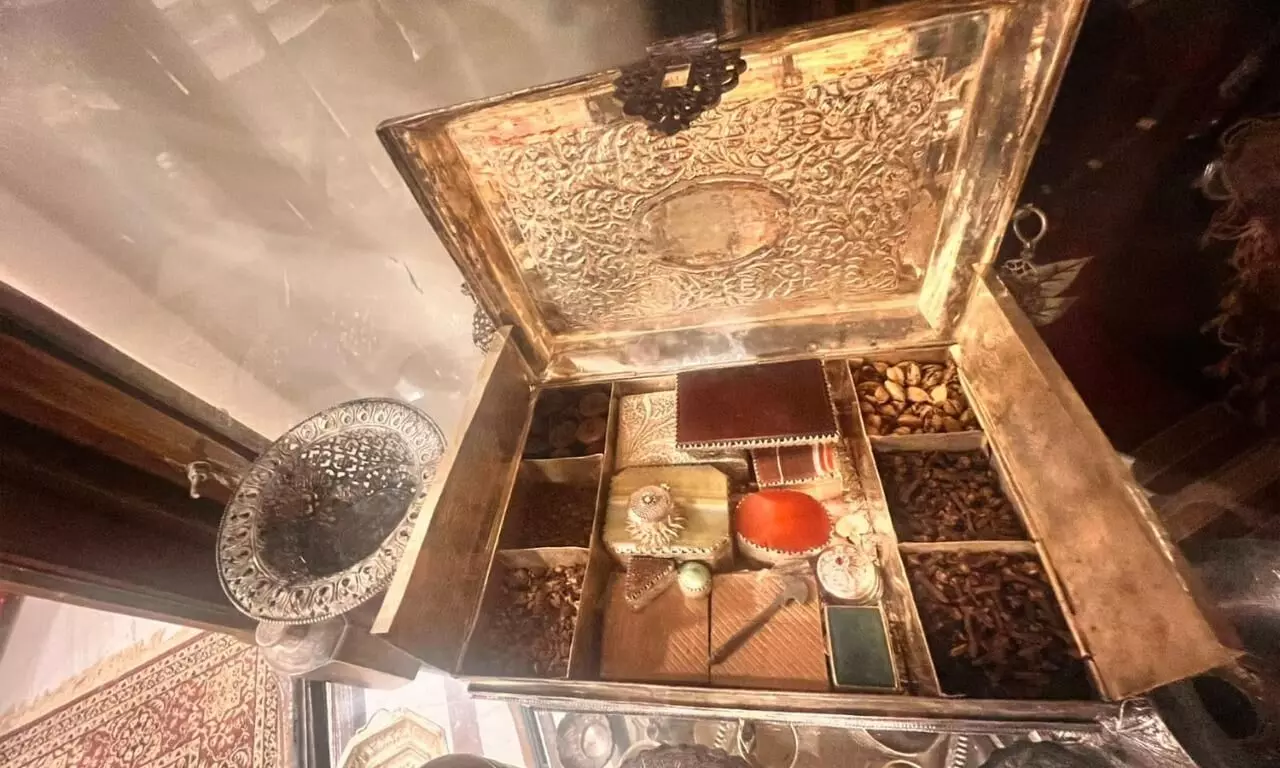Paandaan a well-known example of Hyderabadi tahzeeb
Many Hyderabadis have inherited old paandaans in their homes, and some of them even have 75- to 100-year-old paandaans

HYDERABAD: Ever visited a Pakka Hyderabadi home for Daawat? If so, I'm sure you've seen a "Paandaan," from which homemade paan is typically served after a delicious meal.
Paandaan is a well-known example of Hyderabadi tahzeeb (culture). It is a fully equipped, ornate piece of sterling silver that is inherited by many Hyderabadi families.
Paan is traditionally made with zarda (tobacco), saunf (fennel seeds), supari, chunna paste (lime), katha, ilachi (acacia), catechu, and laung (clove). The traditional homemade paan, 'beeda', is held with a laung (clove). A little box in the shape of a leaf with tiny holes called a 'Nagar Daan' was used to store fresh paan, or beetle leaf.
Pic Credits: Aun Mehdi
No matter what, no Hyderabadi can conclude Daawat without serving their freshly made homemade paan from their paandaans. Many Hyderabadis have inherited old paandaans in their homes, and some of them even have 75- to 100-year-old paandaans.
Pic Credits: Haseeb Jafferi
Dr. Haseeb Jafferi, a descendant of Salabath Jung, the fourth Nizam of Hyderabad, recalled the history of Paandaan by stating that for decades, the paan and Paandaan were used with great manners and were known as Adab-e-Paandaan. It demonstrated people's cultural literacy, he said.
Paandaan has long been used as the sociocultural metaphor of Hyderabad. It's evident that Hyderabad's cultural development has been overlooked; despite the fact that the Paandaan was historically linked to the city's culture, dishes like Biryani and Haleem are the only ones that come to mind when we think of Hyderabad.
According to Jafferi, Nawab Salar Jung Bahadur would request paan for his guests as a sign that it was time for them to depart. Additionally, during significant discussions in the nawabs' courts, a paan would be presented.
Pic Credits: Haseeb Jafferi
"When Nawab Salar Jung Bahadur's guests were served paan, they would chuckle and signal to one another that the meeting was over. After the task was discussed, one of the attendees would voluntarily take the paan, indicating that he had agreed to do the job. "Such was the paan's cultural significance," Dr Haseeb Jafferi said while explaining the significance of the paan's culture in Hyderabad.
Dr. Haseeb Jafferi, Cultural Curator of Sufi Trails and an avid Paandaan collector, owns a sizable collection of vintage Pandaans, including three complete sets and numerous single boxes.
Haseeb Jafferi recalls, "Eating paan from a paan shop was once frowned upon because people who couldn't afford a Paandaan or couldn't afford to keep a Paandaan only ate paan from a paan shop. The majority of Hyderabad's affluent families, whether Hindu or Muslim, had Paandaans who could make any type of paan at home. They also only smoked premium-quality tobacco leaves back then, which smelled divine. They would spit only in a proper spittoon".
Pic Credits: Aun Mehdi
Chewing paan or beetle leaf has been popular for centuries, and as human lifestyles have changed, so have the consumption rate and ingredients of the paan. Only the nobles and ministers of Qutub Shah had the right to keep Paandaan and as well as 'Dabbabardar' a person in charge of Paandan, said Aun Mehdi, great grandson of Nawab Alam Yar Jung.
Aun Mehdi, whose family owns 100-year-old Paandaan, says, "When Allama ibn e Qatoon, the then Prime Minister of Golconda, became enraged by Sultan Abdullah Qutub Shah's actions, the latter ordered his 'Dabbabardar' to prepare a few paans and present them to the enraged Minister. Offering paan directly from one's personal pandaan sometimes reflected one's remorse and was interpreted as an indication of making amends for discourteous behaviour ".
Pic Credits: Aun Mehdi
According to Mehdi, during the Asif Jahi Era, women in Hyderabad began chewing paan and maintaining female Pandan attendants also known as 'Paan-Kaniz'.
The royal harem and descendants of other Asif jahs used to receive 'paan ki nazar,' a monthly cash allowance from the exchequer to the ladies for the maintenance of their pandaan, which lasted until 1950, he added.
The most beautiful piece in the entire paan Daan was a 'Paan ki Bel' or 'Paan ka Jhumar" which was basically a Silver jhumka with Silver clove towards the end of silver chains used for piercing 'Paan ka Beda" (finished pan rolls) which would be ceremonially ordered to guests or friends in a 'khas Daan'. Picking a Paan ka beda would be preceded by offering 'paan ki nazr'- a small amount of cash, said Aun Mehdi.
Pic Credits: Aun Mehdi
As soon as the first Islamic month of Muharram began—a month completely dedicated to mourning—chewing paan was prohibited in almost all homes as a sign of 'Tark e Lawazmat,' or simplicity and austerity. Pan kaniz would be removed from their duties or given control of the zenani ashoor khanas, and paandans would be kept locked (mourning house), explains Mehdi.
"Chewing paan is now considered a layman's "shouq. However, gifting pandans to brides on the occasion of their wedding is a tradition that is still practised in old Hyderabadi families, with the intention of displaying and offering pandans to guests on special occasions and festivals," says Aun Mehdi.



